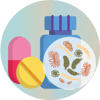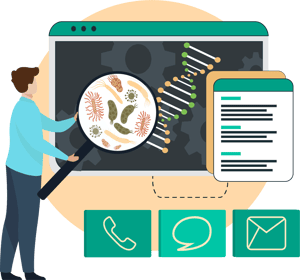The great potential of microbiome analysis
Microbes: you can’t see them, but you can find them almost anywhere on earth – including inside you. The bacteria, viruses, and fungi on our planet come in millions of different shapes and sizes, and their numbers are simply dazzling. For instance, on our planet, there are more viruses than grains of sand, with an estimated 10 nonillion viruses versus a measly 7 quintillion sand grains. Just like the organisms we can see with our naked eyes, bacteria, viruses, and fungi live together within habitats, or “biomes”, which in the case of microbes are referred to as “microbiomes”. And, even if we only consider the numbers of microbes alone, it’s not very surprising that these microbiomes impact, well, almost everything. Including you.
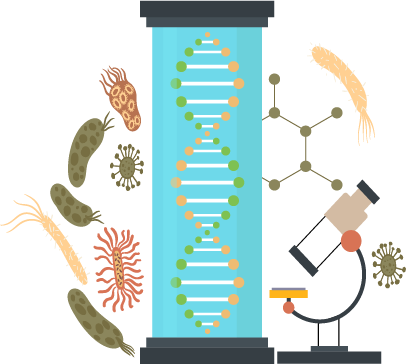 If we zoom in just to just one human, like you, there are about the same number of bacterial cells as human cells in your body – and that’s not even considering the viruses and fungi that co-inhabit your body! This means that by a raw count of cells, you’re mostly microbial. So, it only makes sense that we should characterize and understand those non-human cells that make up your microbiome.
If we zoom in just to just one human, like you, there are about the same number of bacterial cells as human cells in your body – and that’s not even considering the viruses and fungi that co-inhabit your body! This means that by a raw count of cells, you’re mostly microbial. So, it only makes sense that we should characterize and understand those non-human cells that make up your microbiome.
One of the most promising and complete ways to investigate microbiomes is to look at these communities on a genetic level. Genetic analyses allow researchers to identify which microbes are present in what amounts, and what they are doing on a functional level.
In the last decade, microbiome analyses have shed a lot of light not only on the roles of human gut microbiomes in different diseases but also on the positive effects that a healthy microbiome can have on its human host. However, the relevancy of microbiome analyses doesn’t stop there – they can be used for a wide range of research areas, from investigating how soil microbiomes affect crop yields, to understanding the importance of microbes in aquatic environments, and more. In this blog, we’ll highlight some of the main fields of research where microbiome analysis has a significant impact. Ready? Let’s roll.
A mind-blowing gut-brain connection
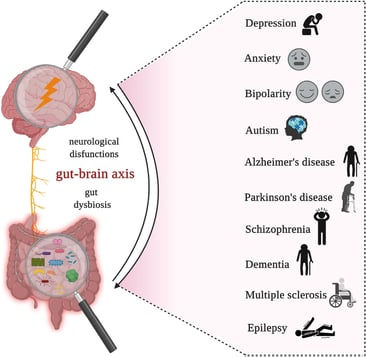 Did you know that your gut can act as a “second brain”? Although the interactions in this so-called gut-brain axis are very complex, it is beyond dispute that our gut microbiome is linked to an abundance of important processes in our brain. For example, research has shown that specific metabolites produced by gut bacteria can influence brain serotonin levels. In other words: what happens in your gut can influence how happy you feel – no surprise for the gourmets among us!
Did you know that your gut can act as a “second brain”? Although the interactions in this so-called gut-brain axis are very complex, it is beyond dispute that our gut microbiome is linked to an abundance of important processes in our brain. For example, research has shown that specific metabolites produced by gut bacteria can influence brain serotonin levels. In other words: what happens in your gut can influence how happy you feel – no surprise for the gourmets among us!
We’re not even close to fully mapping all of the connections and underlying mechanisms along the gut-brain axis. However, the relatively recent realization that the gut microbiome extensively impacts the human brain has led scientists to now consider the gut microbiome as a serious force to be reckoned with when studying processes in the human brain. Imbalances in gut microbiota are now recognized to be associated with a host of neurological and behavioural conditions, from multiple sclerosis and epilepsy all the way to anxiety and depression.
Image taken from: Mitrea L, et al. (2022) Guts Imbalance Imbalances the Brain: A Review of Gut Microbiota Association With Neurological and Psychiatric Disorders. Front. Med. 9:813204. doi:10.3389/fmed.2022.813204
In the last few years, microbiome research has provided major steps forward in order to better understand the gut-brain interplay and has given scientists important clues about how optimizing our gut microbiome could promote brain health.
Harnessing the agricultural power of soil microbiomes
In 2022, the world population is projected to hit 8 billion. There are more and more people to feed, and between expanding cities and the necessity to protect the remaining wild spaces on the earth, increasing the amount of land allocated to agriculture is becoming a less realistic option. So, how will we be able to produce enough food to feed our entire population? To do so, we will need to optimize farming practices to maintain or boost crop yields in our changing environment, while at the same time decreasing the ecological impact of agriculture. And, this is where microbes come in. Microbiomes affect the growth of agricultural crops on many different levels. For instance, soil bacteria and fungi that surround the roots of plants help provide crops with the right nutrients and improve resilience to environmental stresses and diseases. In exchange, plants provide sugar to the soil microbes that they partner with, effectively sucking carbon out of the atmosphere and pumping it (in the form of sugar) into the ground. It makes sense, then, that understanding these complex plant-microbe relations using microbiome research can play a critical role in the creation of a sustainable and future-proof agriculture system.
There are many microbiome-based applications that could improve how we work in our fields. For example, microbiome analysis could help us to create the ideal soil for each different crop. By monitoring which types of bacteria correlate with certain beneficial crop traits, and eventually supplementing soils with those magnanimous microbes, we could boost crop yields. Many companies are already using these insights to develop superior agricultural biologicals. Another promising application of microbiome analyses is related to insect-plant interactions. Insects can have either beneficial (insects are great pollinators) or harmful (insects are great pests, too) impacts on crop yields, and for many insects, their microbiome has been shown to affect how they interact with plants. Research into how insect microbiomes can impact insect-plant interactions is still in its infancy, but it holds great potential to make pest and pollination management more sustainable.
Harvesting good results for the food industry
Take a look at your lunch. Sure, there is food that you can see just fine with your naked eye, but there are also a lot of microbes on your plate. It’s nothing to worry about – all of our food products have microorganisms growing on or in them. That has always been the case; it’s completely normal and oftentimes actually supports your gut health by supplementing your intestinal microbiome with new microbes that you ingest together with your food. However, there are definitely some bugs that you don’t want to end up eating. Salmonella might spring to mind – food contamination with some strains of this bacterium can cause serious food poisoning. And it doesn’t end with Salmonella. Although there are far more bacteria and fungi that are harmless or beneficial to us, there are still quite a few out there that can cause us some serious stomach trouble, or worse. As such, it’s crucial to monitor which microbial species are living on and in our food and water, before they hit your local grocery store. Historically, food testing was done by physically ‘growing’ the bacteria, yeasts, and other microorganisms from food sources in the lab. However, nowadays it is becoming more and more common for food safety laboratories to apply microbiome sequencing technologies to quickly map out all of the microorganisms in our food. This gives a much more complete overview of which microbes are present.
As we hinted at above, many microorganisms are actually helpful to us, and not only via the gut-brain axis or in agriculture. Microbes can also be a crucial partner in the production of different foods. Many different bacteria and fungi steer the fermentation process that is essential for the production of staple foods and drinks such as bread, dairy products, beer, and wine. For food producers, knowing exactly which microbes are present and how they impact the production process can be a huge advantage. Analyzing the microbiome present in and in foods can inform food producers about how to adapt and optimize production processes, or even enhance their end products by making them last longer, have more and better nutrients, or even a specific new taste.
A tidal wave of possibilities for aquatic research
The ocean covers more than two-thirds of the surface of the earth, and it is bursting with life, but we’ve barely scratched the surface of understanding it. We are definitely making progress – each year, almost 2000 new aquatic species are described – but it’s undeniable that we still have a lot to learn about the world’s oceans, rivers, and lakes. If you were to simply walk into the water at your local beach, scoop up a bucket of water, and then analyze the environmental DNA (eDNA) in it, chances are that you would discover a previously unknown microbial species. In fact, the Smithsonian institute estimates that a single liter of coastal water can contain up to one billion bacteria and 10 billion viruses. We are now beginning to understand that all of those microbes can have a dramatic impact on the health of the rest of the oceans’ inhabitants. For instance, research has shown that it is microbes that give squids their characteristic bioluminescence, and blowfish their infamous neurotoxin. Future analyses of marine microbiomes definitely have the potential to shed light on other mysteries within our oceans.
Aquatic microbiome research also has great commercial and environmental potential. Assessing water microbiomes over time can give crucial insights into water quality, and inform waste management and toxicology assessments. Likewise, regularly sampling water can also signal the arrival of invasive species, whose habitat ranges might change or expand dramatically as our climate changes, with potential impacts on the health of fishing stocks and other marine life. A better understanding of aquatic microbiomes could also be used to optimize aquaculture in a manner similar to that of agriculture on land. Just like land plants, aquatic organisms work together with microbes to thrive. Lastly, we are only beginning to understand how much plastic has unintentionally ended up in our oceans. According to the Plastic Soup Foundation, between 5 and 13 million tons of plastic is drifting within our seas. Recent research has suggested that as our pollution levels increase, bacteria may have begun to evolve the ability to break down the plastic we put into the environment. Perhaps these microbes could serve as an unexpected helping hand in addressing our plastic pollution problem – and microbiome analysis can allow us to figure out which bacteria are the ones up to this task.
Microbiome analysis in drug development
Companies that develop new drugs have the responsibility to determine the safety profile, including any unintended side effects, of new drugs coming to the market. We have already covered how the human gut microbiome plays an important role in human health, including brain functioning, so it only makes sense that measuring the effects of drugs on the human gut microbiome has become an important part of drug safety assessments.
Any drug that you take in the form of a pill will pass by the gut at some point. When this happens, at least some of the trillions of microbes in the gut will also interact with those drugs. There are many potential impacts of microbe-drug interactions. For example, microbes might break down the incoming drug, which, depending on the drug, might either increase or decrease its efficacy and therapeutic outcome for patients. Or, some drugs might kill certain gut microbes, which could lead to unintended negative side effects for the patient. With this in mind, analyzing the effects of the human microbiome on drugs, and of drugs on the human microbiome, has become an important consideration when testing drug safety and efficacy.
The growth of microbiome analyses has also impacted drug development in another way. As we hinted at earlier, the abundance of studies linking microbiome composition and activity with human health and disease has triggered the development of new microbiome-targeting therapies. Although it’s still one of the ‘new kids on the block’ in therapeutic approaches, the use of microbiome-targeting therapies is an exciting and promising approach for a wide range of diseases.
Microbiomes make the world go round
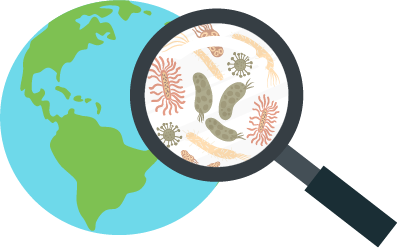 Microbes have a huge impact on human health and society through their key roles in the gut-brain axis, agriculture, the food industry, aquatic sciences, and even drug development. These areas of study and industries all benefit significantly from microbiome research. At BioLizard, we see the rising demand for statistical analysis in microbiome projects.
Microbes have a huge impact on human health and society through their key roles in the gut-brain axis, agriculture, the food industry, aquatic sciences, and even drug development. These areas of study and industries all benefit significantly from microbiome research. At BioLizard, we see the rising demand for statistical analysis in microbiome projects.
To get better insights into microbial composition and microbial community dynamics and to unravel causality, we have created a new computational tool: proBiome.
proBiome is an innovative computational pipeline that we use to investigate and monitor results from microbiome research. We have included some unique features that allow us to study in great detail how changes in microbiomes can have biological impacts. Be one of the first to discover what this can mean for your research, and talk to our microbiome experts. We’d love to see how we can help enhance your microbiome research.
I want to talk to the microbiome experts!






